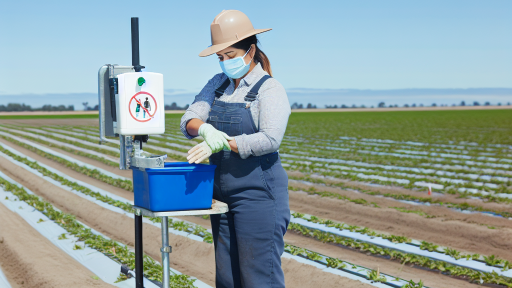Understanding the Importance of Research Funding in Agriculture
Enhancing Innovation
Research funding plays a crucial role in enhancing innovation within the agricultural sector.
This funding enables farmers to access new technologies and methodologies.
As a result, operations can become more efficient and sustainable.
Innovative practices lead to better yields and improved crop resilience.
Moreover, research funding helps bridge the gap between traditional practices and modern advancements.
Driving Economic Growth
Investing in agricultural research can significantly drive economic growth.
Increased productivity translates into greater profits for farmers.
Furthermore, it creates jobs within rural communities and beyond.
The ripple effects can stimulate local economies and enhance food security.
Addressing Challenges
Agriculture faces numerous challenges, including climate change and pest pressure.
Research funding facilitates the development of solutions to these pressing issues.
For example, funding can support the creation of drought-resistant crops.
Such innovations ensure that farmers can adapt to changing environmental conditions.
Encouraging Collaboration
Research funding fosters collaboration between farmers, researchers, and institutions.
This collective effort leads to shared knowledge and resources.
Transform Your Agribusiness
Unlock your farm's potential with expert advice tailored to your needs. Get actionable steps that drive real results.
Get StartedIn addition, partnerships can drive large-scale projects that benefit entire regions.
Collaboration amplifies the impact of individual contributions.
Promoting Sustainable Practices
Funding research also encourages the adoption of sustainable farming practices.
These practices help preserve natural resources for future generations.
For instance, studies funded by research grants promote integrated pest management techniques.
Such techniques reduce chemical usage and minimize environmental impacts.
Ultimately, sustainable practices contribute to long-term agricultural viability.
Identifying Potential Funding Sources for Farming Innovation
Government Grants and Programs
Various government agencies offer funding specifically for agricultural innovation.
The United States Department of Agriculture (USDA) provides several grants geared towards farmers.
These grants can help with research, development, and the implementation of new technologies.
It is essential to stay updated on application deadlines and requirements.
Check state and local government resources for additional funding opportunities.
Private Foundations and Nonprofits
Many private foundations support innovative agricultural projects.
Organizations like the Bill & Melinda Gates Foundation focus on sustainable farming practices.
They often provide funding for projects that demonstrate significant environmental and social impact.
Research potential nonprofit organizations aligned with your goals for additional support.
Crowdfunding Platforms
Crowdfunding can be a viable option for funding farming innovations.
Platforms like Kickstarter and Indiegogo allow you to present your project to the public.
Successful campaigns often highlight unique solutions or community benefits.
Leverage social networks to promote your crowdfunding efforts effectively.
University Research Collaborations
Partnering with universities can open up funding opportunities.
Many academic institutions have research grants for agricultural studies.
Collaborating with faculty can enhance your project’s credibility and reach.
Explore ongoing research initiatives that align with your farming operation’s objectives.
Showcase Your Farming Business
Publish your professional farming services profile on our blog for a one-time fee of $200 and reach a dedicated audience of farmers and agribusiness owners.
Publish Your ProfileIndustry Partnerships
Forming partnerships with agricultural tech companies can provide funding options.
Many companies seek to collaborate on innovative projects in exchange for insights.
These partnerships can be mutually beneficial, helping both parties grow and innovate.
Consider reaching out to firms that align with your farming practices and goals.
Developing a Strategic Plan for Using Research Grants Effectively
Identifying Relevant Research Grants
Start by researching available grants tailored to agriculture.
Check government websites for agricultural funding opportunities.
Attend workshops to learn about potential grants and eligibility.
Collaborate with agricultural universities for partnership opportunities.
Defining Goals and Objectives
Establish clear goals for your farming operation.
Align your objectives with the grant’s purpose and requirements.
Communicate your vision to all stakeholders involved.
Set measurable targets to track progress throughout the project.
Creating a Comprehensive Budget
Draft a detailed budget that covers all necessary expenses.
Include direct and indirect costs in your financial planning.
Ensure your budget aligns with the funding limits of the grant.
Consider future expenses related to sustainability and growth.
Developing a Project Timeline
Create a timeline outlining all phases of the project.
Assign specific deadlines to each task and responsibility.
Plan for contingencies to address potential delays.
Use timeline tools to visualize the project’s progress.
Designing an Evaluation Strategy
Establish criteria for evaluating the project’s success.
Collect baseline data before the project begins.
Schedule regular check-ins to monitor progress toward objectives.
Adapt your strategies based on evaluation results.
Building Partnerships and Collaborations
Identify potential collaborators who share your vision.
Engage local agricultural organizations for support.
Create a network for sharing resources and knowledge.
Foster communication to strengthen partnerships throughout the project.
Learn More: The Role of Animal Welfare Laws in Modern Farming Practices
Case Studies: Successful Farming Operations Utilizing Research Funding
Innovative Practices at Green Field Farms
Green Field Farms secured funding from the National Agriculture Innovation Center.
They focused on developing drought-resistant crop varieties.
This initiative significantly reduced water usage on the farm.
As a result, crop yields improved by 30% over two years.
Additionally, their research collaborated with local universities.
This partnership brought in fresh expertise and cutting-edge technology.
Transformative Changes at Maple Leaf Organics
Maple Leaf Organics utilized a USDA research grant to innovate their processes.
They implemented precision agriculture techniques to monitor soil health.
This technology helped optimize fertilizer usage effectively.
Consequently, they reduced chemical costs by 25% annually.
Moreover, their produce gained recognition in local farmer’s markets.
Showcase Your Farming Business
Publish your professional farming services profile on our blog for a one-time fee of $200 and reach a dedicated audience of farmers and agribusiness owners.
Publish Your ProfileAdvancements in Livestock Management at Sunny Acres Ranch
Sunny Acres Ranch received funding for research in livestock genetics.
They focused on improving disease resistance in their cattle population.
This effort led to a significant drop in veterinary expenses.
Furthermore, the ranch reported a 40% increase in livestock productivity.
Collaboration with agricultural scientists ensured ongoing improvements.
Sustainable Practices at River Valley Farm
River Valley Farm embraced sustainable methods through research funding.
They introduced cover cropping to enhance soil health.
This practice not only prevented erosion but also improved biodiversity.
Moreover, their yields increased alongside soil quality improvements.
Additionally, River Valley Farm shared their findings with the community.
They conducted workshops to promote sustainable practices among peers.
Explore Further: Understanding Climate Change Laws for Modern Farmers
Innovative Technologies in Farming: Where Research Meets Practice
Introduction to Innovative Farming Technologies
Innovative farming technologies drive advancements in agricultural practices.
Research plays a vital role in developing these technologies.
Farmers can utilize new tools to improve their operations.
Precision Agriculture
Precision agriculture allows farmers to optimize their land use.
This approach utilizes data analytics for informed decision-making.
For instance, farmers use GPS and sensors to monitor crop health.
As a result, they can reduce waste and increase yield.
Key Components of Precision Agriculture
- GPS technology for mapping and tracking.
- Drones for aerial imagery and surveillance.
- Data analytics software to interpret data.
Biotechnology in Crop Production
Biotechnology significantly enhances crop production techniques.
This includes genetic engineering to create resilient crop varieties.
Farmers benefit from crops that resist pests and harsh climates.
Furthermore, this technology leads to more sustainable practices.
Examples of Biotech Innovations
- Crops engineered for drought resistance.
- Genetically modified organisms (GMOs) for increased nutrient content.
- Biopesticides that maintain ecological balance.
Robotics and Automation
Robots are revolutionizing various agricultural tasks.
Automated machinery improves efficiency on farms.
For example, robotic systems can plant and harvest crops.
This technology reduces the need for manual labor.
Benefits of Robotics in Farming
- Increased operational efficiency.
- Reduction in labor costs.
- Enhanced precision in farming practices.
Sustainable Practices and Research Funding
Research funding supports sustainable farming innovations.
Grants often focus on environmentally friendly technologies.
This initiative encourages farmers to adopt greener practices.
Moreover, research leads to discovering new sustainable methods.
Areas of Research Focus
- Soil health and conservation techniques.
- Water management and irrigation efficiency.
- Integrated pest management strategies.
Leveraging research funding fosters innovation in farming operations.
By adopting innovative technologies, farmers can thrive in a competitive market.
Ultimately, these advancements lead to more sustainable and productive agriculture.
Delve into the Subject: How To Apply For Agricultural Conservation Programs

Measuring the Impact of Research Funding on Farm Productivity and Sustainability
Improving Farm Productivity
Research funding plays a critical role in enhancing farm productivity.
First, it allows farmers to access innovative technologies.
New technologies can lead to higher crop yields.
Moreover, funding supports research into crop resilience.
This resilience is crucial in adapting to climate change.
Showcase Your Farming Business
Publish your professional farming services profile on our blog for a one-time fee of $200 and reach a dedicated audience of farmers and agribusiness owners.
Publish Your ProfileFarmers can also implement advanced farming techniques.
Techniques such as precision agriculture maximize efficiency.
As a result, the overall productivity of the farm increases.
Enhancing Sustainability Practices
Research funding also encourages sustainable farming practices.
These practices help in minimizing environmental impacts.
For instance, funding may support organic farming research.
This research leads to healthier soil and ecosystems.
In addition, sustainable practices reduce dependency on chemicals.
Farmers benefit from diversifying their crop rotations.
Such diversification enhances soil health and reduces pests.
Ultimately, this creates a more sustainable farming model.
Highlighting Economic Benefits
Investment in research funding provides significant economic benefits.
It boosts local economies by creating new job opportunities.
Furthermore, higher productivity often results in increased income.
Farmers can expand their operations through reinvestment.
Additionally, sustainable practices may lower input costs.
In the long run, this leads to greater profitability.
Making Informed Decisions
Farmers can access valuable insights from research outcomes.
This information guides decision-making processes.
For example, best practices for water management emerge from research.
Farmers can implement these practices effectively.
Consequently, efficient water use conserves resources.
Moreover, informed decisions often result in better crop quality.
Ultimately, this enhances the marketability of produce.
Collaborative Opportunities
Research funding also fosters collaboration among stakeholders.
Farmers can partner with universities and research institutes.
This collaboration leads to shared knowledge and resources.
Additionally, joint projects often yield innovative solutions.
Farmers can take part in pilot programs to test new techniques.
This hands-on experience accelerates the adoption of innovations.
Moreover, community engagement strengthens networks within the industry.
Find Out More: Compliance Strategies for Farm-To-Table Legislation in Modern Farming
Collaborating with Research Institutions to Enhance Farm Innovations
The Importance of Collaboration
Collaborating with research institutions can transform your farming operation.
These partnerships bring valuable expertise and resources.
They help farmers access cutting-edge technologies.
Moreover, collaboration fosters innovative solutions to common farming challenges.
Identifying the Right Research Partners
Finding the right research institution is crucial.
Consider universities with strong agricultural programs.
Look for research centers focusing on your specific crop or livestock.
Additionally, evaluate institutions that prioritize practical applications of their research.
Showcase Your Farming Business
Publish your professional farming services profile on our blog for a one-time fee of $200 and reach a dedicated audience of farmers and agribusiness owners.
Publish Your ProfileDefining Clear Objectives
Establish clear goals for your collaboration.
Ten specific objectives guide the research direction.
Identify areas needing improvement within your operation.
Discuss these objectives with your research partners early on.
Funding Opportunities
Research grants can provide essential funding.
Explore government and private sector funding options.
Many organizations support agricultural innovation and sustainability.
Apply for grants that align with your project goals.
Implementation of Research Findings
Once you gain insights, focus on implementation.
Adapt research findings to fit your farm’s unique context.
Share experimental results with your team to foster understanding.
Evaluate the impact of implemented changes regularly.
Measuring Success
Develop metrics to assess the success of your collaboration.
Track yield improvements or cost reductions resulting from research.
Consistency in measuring outcomes is key to understanding benefits.
Regularly communicate these results with your research partners.
Building Long-Term Relationships
Foster long-term partnerships with research institutions.
Continued collaboration leads to ongoing innovation.
Engage in joint projects to strengthen these ties.
Attend workshops and conferences together to share findings.
Navigating the Application Process for Agricultural Research Grants
Understanding Grant Types
Research grants vary in their focus and funding sources.
Federal programs often support large-scale initiatives.
State grants might promote local agricultural innovations.
Private foundations frequently back specific research interests.
Understanding these differences helps tailor your application effectively.
Identifying Funding Opportunities
Start by researching available grants in your area.
Use databases that compile various funding options.
Regularly check government websites for new announcements.
Networking with local agricultural organizations is also beneficial.
This helps uncover opportunities that may not be widely advertised.
Preparing Your Application
Begin by thoroughly reading the grant guidelines.
Each grant will have specific requirements to meet.
Clearly define the objectives of your research project.
Ensure your project aligns with the funder’s goals.
Gather necessary documentation early in the process.
Writing a Compelling Proposal
A strong proposal tells a clear and engaging story.
Begin with a powerful introduction to your project.
Detail your methodology to demonstrate its feasibility.
Include realistic timelines and budgets to show planning.
Highlight the potential impact of your research on agriculture.
Showcase Your Farming Business
Publish your professional farming services profile on our blog for a one-time fee of $200 and reach a dedicated audience of farmers and agribusiness owners.
Publish Your ProfileSeeking Feedback Before Submission
Before submitting, seek input from trusted peers.
They can provide valuable perspectives on your proposal.
Consider revising your proposal based on their suggestions.
A fresh pair of eyes can catch errors you might overlook.
Finally, ensure that your application adheres to the formatting guidelines.
Additional Resources
Adaptation and development pathways for different types of farmers …




